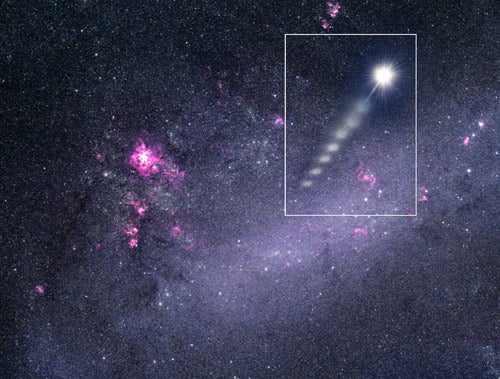A massive young star is speeding through the Milky Way’s halo. Its age and extreme speed hints a black hole in the center of our neighboring Large Magellanic Cloud (LMC) may have sent it on its way.
The Milky Way’s halo contains the galaxy’s oldest stars, roughly 10 billion years old. The recently discovered star, known as HE0457-5439, is a B-type main sequence star roughly 30 million years old. Therefore, it must be passing through from elsewhere.
Given the star’s high velocity of 450 miles per second (723 kilometers per second), astronomers suspect something must have accelerated the star. Calculations done in the late 1980s showed a supermassive black hole can provide an extreme acceleration kick.
Researchers at the Dr. Remeis-Sternwarte, (the astronomical institute of the University of Erlangen-Nürnberg, Germany) and the Centre for Astrophysics Research (University of Hertfordshire, United Kingdom) discovered HE0457-5439. The scientists were using one of the 8.2-meter telescopes composing the European Southern Observatory’s Very Large Telescope to detect quasars.
The team calculated it would take the star more than 3 times its age to travel from the Milky Way’s center to its present location in the halo. This means “either the star is older than it appears or it was born and accelerated elsewhere,” says Uli Heber of Dr. Remeis-Sternwarte. Given the star’s proximity to the LMC, the astronomers believe the star may have been accelerated by a supermassive black hole and ejected from the LMC’s center.
Additional observations are required to determine if HE0457-5439 did, in fact, originate from near LMC’s center, or if there’s another reason for the star’s high velocity.
The team’s research can be found in the December 1, 2005, issue of The Astrophysical Journal Letters.










